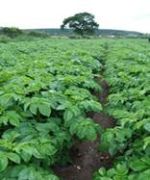主标签
Space age agronomy on show at the World Potato Congress

World potato Congres 2012
Satellite technology developed during the cold war is set to deliver state-of-the-art crop monitoring systems to help growers improve agronomy and drive up profits. Although the technology dates back several decades, its capabilities for remote sensing of crops are only now being realised thanks to relatively recent developments in information technology, says Stephanie Race, chief executive of San Francisco-based Earth Analytics Group, who will be speaking at World Potato Congress.
“Satellite remote sensing can inform observations of crop canopy development at scale. When used with meteorology, soils data and crop models, growers can monitor in-season production and reduce water use to achieve more favourable yields at a lower cost,” she explains. “Growers can evaluate many more fields with remotely-sensed data than they could by walking them – we are saving time with technology.”
Information can be used to fine-tune management decisions during the season and to give an accurate prediction of yield in relation to planned harvest dates. This not only helps growers manage their inputs efficiently and plan harvest campaigns better, it also helps manufacturers improve crop supply forecasts, she adds.
 Data can also be used retrospectively to evaluate crop performance, helping to pinpoint areas for improvement in future seasons.
Data can also be used retrospectively to evaluate crop performance, helping to pinpoint areas for improvement in future seasons.
Cambridge University Farm is working with Earth Analytics Group to develop the technology in the UK and further afield. Dr David Firman, head of the Potato Agronomy Group at CUF, says better canopy measurement is the key to improved crop monitoring.
“Crop cover drives crop production and water demand. Current methods of measuring it are primitive and time consuming and can only be used on small areas.
“Bringing satellite imagery together with locally gathered information and yield and irrigation modelling, which we already operate, will allow growers to make more efficient use of resources during the season and will also allow more efficient data capture which can be analysed to provide an element of forecasting and strategic decision-making.”
That will help growers make more informed choices based on actual crop performance and expectations, he adds. “One of the challenges is that people tend to be reactive and go from one season to the next without having all the data to hand to make rational decisions. This will give them the information they need.”
Visitors to WPC can hear more about this novel approach to crop monitoring including real-life examples of growers using it and where future advances might be made, notably through more efficient use of IT.
World Potato Congress takes place every three years, and the 2012 Edinburgh event on 27-30 May is world-class, attracting speakers from the USA, GB, The Netherlands, China, New Zealand, South Africa, Australia and Canada. It will provide a unique opportunity for growers and the whole industry to share information and uncover vital new knowledge.
“Satellite remote sensing can inform observations of crop canopy development at scale. When used with meteorology, soils data and crop models, growers can monitor in-season production and reduce water use to achieve more favourable yields at a lower cost,” she explains. “Growers can evaluate many more fields with remotely-sensed data than they could by walking them – we are saving time with technology.”
Information can be used to fine-tune management decisions during the season and to give an accurate prediction of yield in relation to planned harvest dates. This not only helps growers manage their inputs efficiently and plan harvest campaigns better, it also helps manufacturers improve crop supply forecasts, she adds.

Canopy management
Cambridge University Farm is working with Earth Analytics Group to develop the technology in the UK and further afield. Dr David Firman, head of the Potato Agronomy Group at CUF, says better canopy measurement is the key to improved crop monitoring.
“Crop cover drives crop production and water demand. Current methods of measuring it are primitive and time consuming and can only be used on small areas.
“Bringing satellite imagery together with locally gathered information and yield and irrigation modelling, which we already operate, will allow growers to make more efficient use of resources during the season and will also allow more efficient data capture which can be analysed to provide an element of forecasting and strategic decision-making.”
That will help growers make more informed choices based on actual crop performance and expectations, he adds. “One of the challenges is that people tend to be reactive and go from one season to the next without having all the data to hand to make rational decisions. This will give them the information they need.”
Visitors to WPC can hear more about this novel approach to crop monitoring including real-life examples of growers using it and where future advances might be made, notably through more efficient use of IT.
World Potato Congress takes place every three years, and the 2012 Edinburgh event on 27-30 May is world-class, attracting speakers from the USA, GB, The Netherlands, China, New Zealand, South Africa, Australia and Canada. It will provide a unique opportunity for growers and the whole industry to share information and uncover vital new knowledge.
Like to receive news like this by email? Join and Subscribe!
Get the latest potato industry news straight to your WhatsApp. Join the PotatoPro WhatsApp Community!
精选企业
Sponsored Content
Sponsored Content
相关活动
Sponsored Content
Sponsored Content







